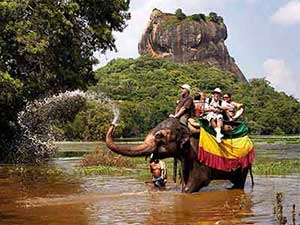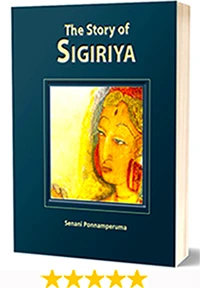Sigiriya Attractions, Things to Do
Sigiriya in central Sri Lanka about a three hour drive from Colombo and Negambo. There are many attractions in close proximity to this site.
Sigiriya Rock Fortress Royal Residence of King Kashyapa and his Harem
Entry Fee: $30
(also includes entry into the Museum)
Opening Hours: 7:00 AM – 5:30 PM (Last entry 5:00 PM).
Visit: 3-4 hours
Climb: 60-90 Minutes to the top
(best time early morning / late afternoon)
The Sigiriya Citadel was a lavish compound protected by two moats and three ramparts. It was the private residence of King Kashyapa and his harem.
The center of this complex was dominated by a menacing black column of rock 600 feet high around which he constructed lush gardens, ponds, palaces and pavilions. He transforms the once sinister-looking rock to appear like a huge bedazzling white cloud. Around its circumference he painted an exquisite multicolored tapestry depicting celestial nymphs. We know these today as the Sigiriya Frescoes. Halfway up this rock he built a massive gatehouse in the form of a sphinx-like lion giving his lair its name, Sigiriya–Lion Mountain. On the summit of this gigantic rock he built himself a gleaming white palace of unparalleled beauty. There, hidden from view, he lived in splendid isolation tormented by guilt and fear. His city thrived for less than fourteen years before it was abandoned and soon forgotten. The ruins seen today are less than 20% of the structures that once graced the area.
Sigiriya Elephant Rides Ride a Lumbering Monster

Fee: $25 (approximately)
Opening Hours: Daylight Hours
Visit: 1 hour
Elephant rides are available near the Sigiriya Wewa. Rides can be of varying duration and usually include an exciting detour into the waters of the lake.
Sigiriya Museum Audio Visual & Artifacts
Entry Fee: $5 (but you don't need to pay this if you have a Sigiriya site ticket)
Opening Hours: 8:30 AM – 5:30 PM (Last entry is at 5:00 PM).
Visit: 30-40 Minutes
The Sigiriya Museum is located about 180 meters from the main entrance. The museum's audio-visual show gives a good background of Sigiriya. The model of the site as it is today provides a good orientation of the site and its vastness. The displays are mediocre being predominately from times other than during the reign of King Kashyapa. The museum bookshop is well stocked with books about Sri Lanka. The recreation of the frescoes is a disappointment.
Pidurangala Rock Pidurangala Rock Temple
Entry Fee: $2 (approximately)
Opening Hours: 8:30 AM – 5:30 PM (Last entry is at 5:00 PM).
Visit: 1-2 hours
Climb: 40-60 Minutes to go to the top
Located about 2kms to the north of Sigiriya, Pidurangala is often overlooked. This site too has an interesting history closely related to Sigiriya. The area has been occupied on and off for over two thousand years by monks who lived in the caves around the site. It really came into the fore when King Kashyapa (477- 495 AD), moved monks living around Sigiriya to a newly refurbished and enlarged monastery here.
Minneriya National Park Minneriya Park Elephant Gathering
Entry Fee: $14 per person (approximately)
Jeep & Guide: $35-50 (depending on where you hire it from)
Opening Hours: 6 - 8:30 and 15:30 - 18:00
Visit: 2-3 hours (inside Park)
Minneriya National Park is located in the Central Province in Sri Lanka. It is about a 45 minute drive (41km) from Sigiriya. The park is centered around the 249 square km Minneriya Tank (reservoir) built by King Mahasena in the third century AD to irrigate agricultural land around the area. With the collapse of ancient Sri Lankan civilization, the land was abandoned and fell into disuse and was quickly engulfed by forest.
The park consists of a mixture of forest, scrub and grassland. It is home 24 species of mammals, 160 species of birds, 9 species of amphibians, 25 species of reptiles, 26 species of fish, and 75 species of butterflies. Some of the more popular wildlife are: deer, elephants, monkeys, and endangered species such as the Sloth Bear and Leopard. The lake attracts a myriad of wild birds such as cormorants, painted storks and pelicans. The park is also home to the ever present peacocks.
The most spectacular event to occur in the park is known as the "Gathering". The best time to see this phenomenon is usually during the dry season (July – September) when water is scarce and animals begin to congregate around the only stable water supply around – the Minneriya Tank. It is a truly spectacular place to see elephants in the wild. Groups of around three hundred and so say as high as seven hundred elephants congregate around the tank to socialize, bathe, drink, feed and possibly mate.
Dambulla Temple Seated Buddha Dambulla Cave Temple
Entry Fee: $14 per person (ticket counter located on left at the main building)
Opening Hours: 7:30AM -7:00PM
Visit: 2-3 hours
The Dambulla Temple is located about 30 minutes (24 km) from Sigiriya. It is the largest and best preserved cave temple in Sri Lanka. It has been a fully functioning temple since its inception over two thousand years ago.
The recorded history of the Dambulla Caves goes back over two thousand years to the time of King Valagama (ruled 103 BC and again 89 BC – 77 BC). The king sort refuge amongst the monks living in these caves when he was ousted from power in 103 BC by South Indian marauders who invaded the country. After a grueling 14 year campaign Valagama finally regained control and in thanksgiving built the original vihara on this site. Since then the site has evolved organically into its present state.
The beauty of the cave temple is its setting into five huge caverns high on a mountainside. Inside are 153 Buddha statues in various reposes, three statues of ancient kings, and four other statues including those of Vishnu and Ganesh. The eyes on some of the statues are interesting.
The ceiling and walls have been painted and repainted over the centuries by the resident monks and contain some interesting juxtapose of imagery including those of royal life. The modern additions at the base of the hill a bit garish and lacking finesse.
Since the ancient site is located on a mountainside there is a rather strenuous climb to the top.
This is a fully functioning temple. So be respective of the worshipers there. Dress appropriately (see Dress Code below). Photography (no flash) is permitted but don't offend local sensibility by posing with the statues especially with your back turned to them. To do so is considered extremely rude and disrespectful.
Dress Code: As with all religious establishments in Sri Lanka, dress modestly. Wear clothes that cover your shoulders and thighs (knee length). Don't wear hats or caps inside the buildings.
